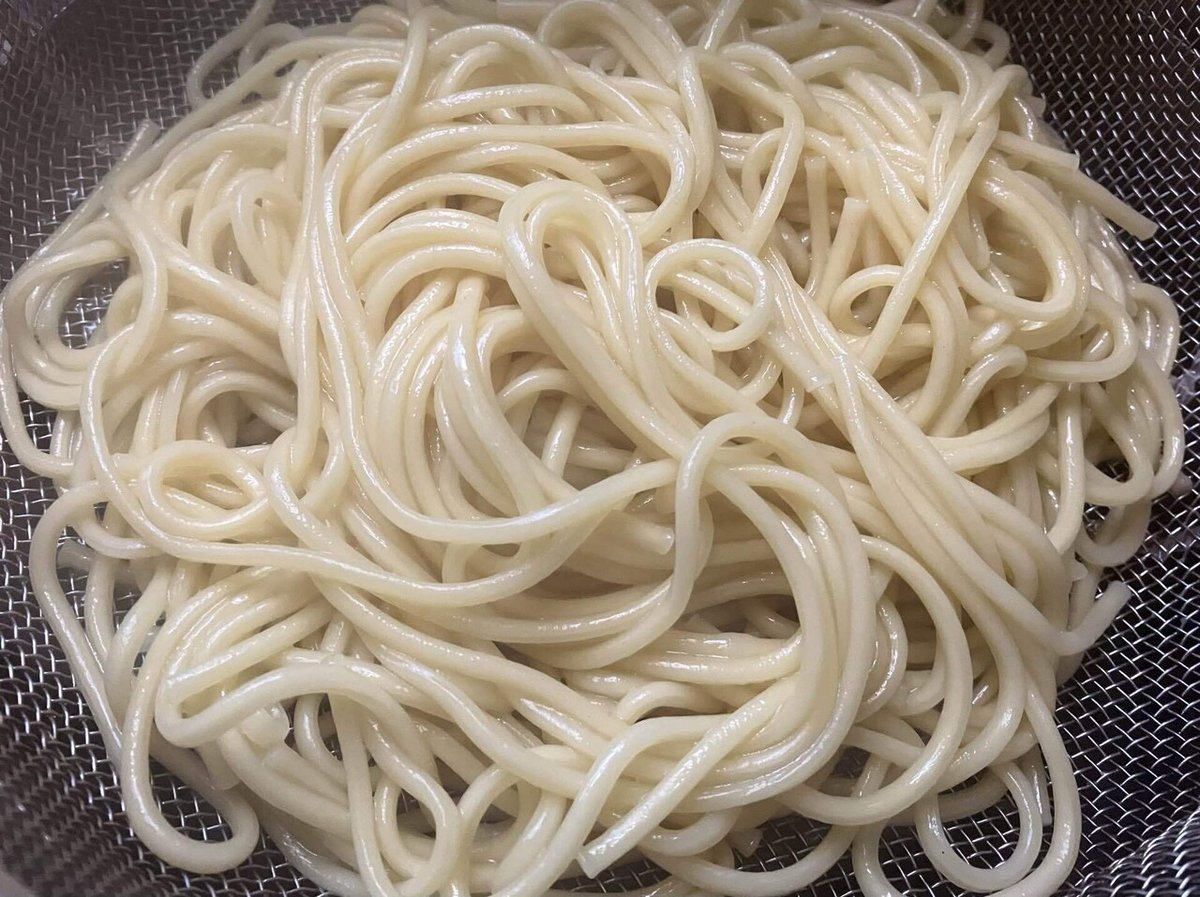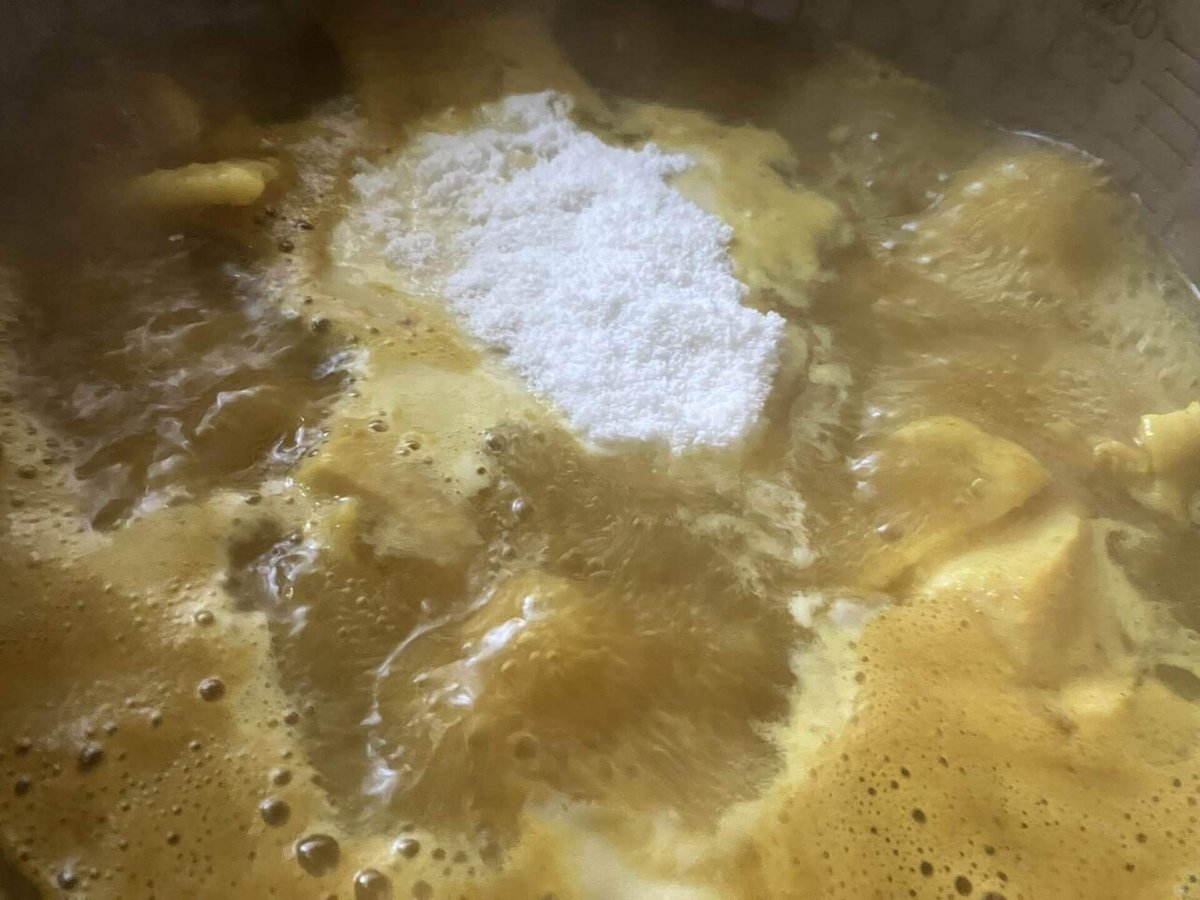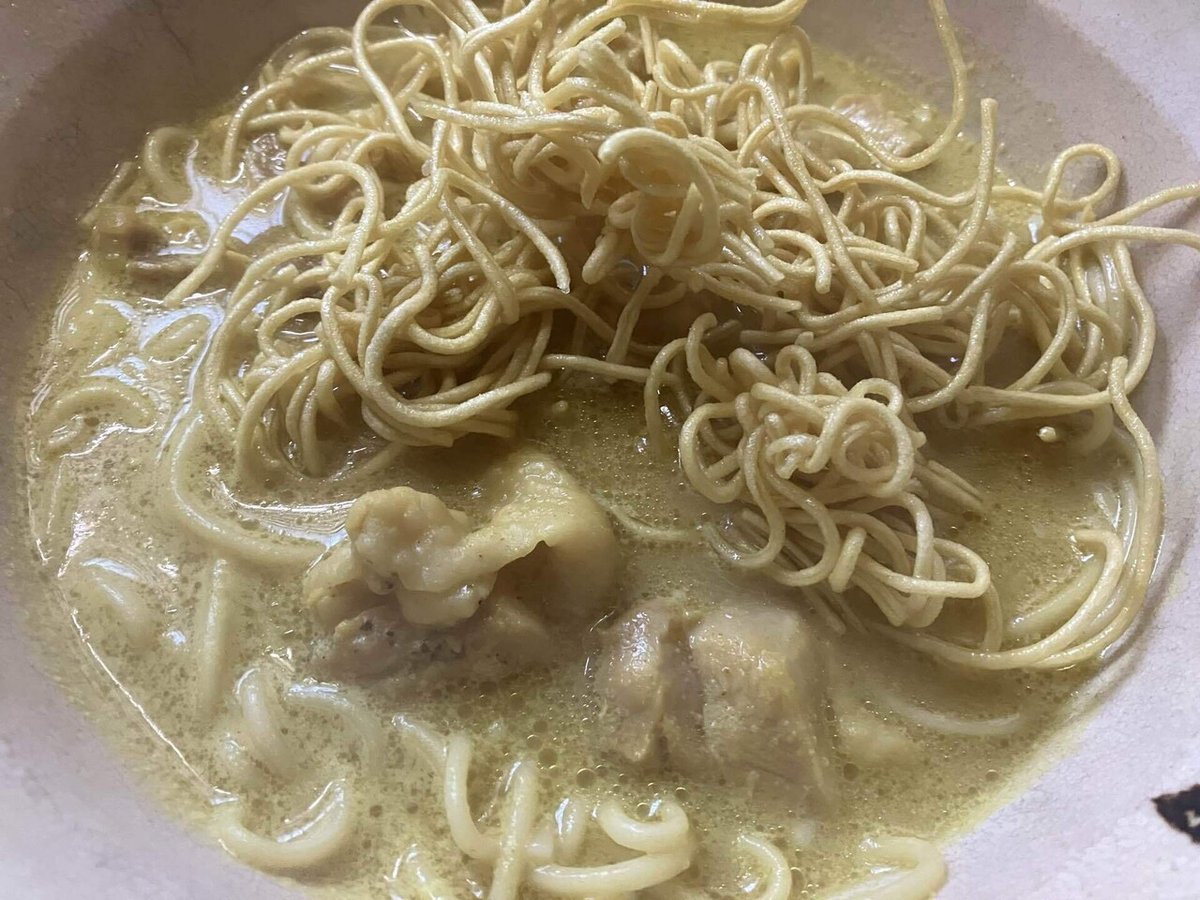
文化融合の傑作麺カオソーイ(グルテンフリー対応可) Khao Soi(Gluten-free options available)
中華乾麺千本ノック
Hard cooking practice with Chinese Dried Noodles
ストーリー Recipe trivia
もう40年近く前になるだろうか、初めてチェンマイに行った時に一番お気に入りだった麺料理がこれだ。日本のラーメンはもちろん、中国や香港、台湾のラーメンも一通り食べていたけれど、ここのはどのカテゴリーにも属さない新鮮な一品だった。当時は日本のラーメンも今みたいな創作流行りではなかったので、色んな食文化要素を見事に統合したこの料理は衝撃だった。聞けば、ミャンマーとタイ北部の名物なのだそうだ。タイには中国文化圏とマレー文化圏とインド文化圏の要素が融合した食文化が根付いているのだけど、そこに、タイ北部ではミャンマー国境を通してイスラム的な要素がさらに加わってくる。カオソーイはそんな文化融合の一杯だ。この料理の他の麺料理にない特筆すべき特徴はニ種類の食感の麺の組み合わせだ。茹で麺と揚げ麺のコントラストに魅惑される。
It must have been almost 40 years ago, when I went to Chiang Mai for the first time, this was my favorite noodle dish. I had tried not only Japanese ramen, but also ramen from China, Hong Kong, and Taiwan, but this was a fresh dish that didn't belong to any category. At that time, Japanese ramen wasn't as creative as it is now, so this dish, which beautifully integrated various food culture elements, was a shock. I heard that it is a specialty of Myanmar and northern Thailand. Thailand has a food culture that is a fusion of Chinese, Malay, and Indian cultural elements, but in northern Thailand, Islamic elements are added through the Myanmar border. Khao Soi is a bowl of such cultural fusion. The unique feature of this bowl that is not found in other noodle bowl is the combination of two different textures of noodles. The contrast between boiled noodles and fried noodles is fascinating.
カオソーイは「米を切ったもの」という意味なのだそうだ。ミャンマーでの原型は米麺を使っていたが、その後、チェンマイに伝わって麺が卵麺に変化し今の形になったらしい。一般的に北部のゲーン(スパイスとフレッシュハーブを使った汁物を指す。日本ではタイカレーと呼ばれている汁物カテゴリー)はバンコクに比べて比較的辛さが控え目だ。
かなり色々なバリエーションが存在するが、原地で一番気に入った鶏肉を使ったものを再現した。
日本の乾麺には卵麺は無いので、通常の中華乾麺を使うけれど、香港の卵麺なら日本でも手に入るので、そちらも試してみると良いだろう。
本格的なタイの調味料を使って作ってみたが、身近に手に入る材料でもそこそこ似た味に仕上げることができるので、レシピには代用の可能性も示しておいた。
元々米麺を使っていて、チェンマイでも麺を米麺に変更できるお店もあるので、別段反則ではない。フォーなどを使えばグルテンフリーになる。
Khao soi means "cut rice". The original version in Myanmar used rice noodles, but it was later introduced to Chiang Mai, where the noodles were changed to egg noodles, resulting in the current form. Generally, northern gaeng (a soup made with spices and fresh herbs; a category of soups known as Thai curry in Japan) is relatively milder than Bangkok.
There are many variations, but I recreated the one I liked most in the original country, using chicken.
Japanese dried noodles do not have egg noodles, so I used regular chinese dried noodles, but Hong Kong egg noodles are available in Japan, so you should try those too.
I tried making it using authentic Thai seasonings, but you can get a fairly similar taste with readily available ingredients, so I've included possible substitutions in the recipe.
It originally used rice noodles, and there are restaurants in Chiang Mai where you can change the noodles to rice noodles, so it's not a violation. If you use something like pho, it will be gluten-free.
Ingredients:
材料:
中華乾麺
手羽元ないし鶏もも
紫玉ねぎ
キャベツの酢漬け※
香菜
にんにく
揚げ玉ねぎ
ココナッツパウダー
コリアンダーパウダー
ターメリックパウダー
カルダモンホール
こぶみかんの葉※
レモングラスの茎※
カランガル※
青唐辛子
タマリンド※
海老ペースト※
黒糖
自然塩
ナムプラー
油
※手に入りにくいけど、他の素材で代用も可能。詳しくはレシピ参照
Chinese dried noodles
Chicken wings or thighs
Purple onions
Pickled cabbage*
Coriander
Garlic
Fried onions
Coconut powder
Coriander powder
Turmeric powder
Whole cardamom
Kaffir lime leaves*
Lemongrass stalks*
Kalangal*
Green chilies
Tamarind*
Shrimp paste*
Brown sugar
Natural Salt
Nam pla
Oil
*It's hard to get hold of, but you can substitute other ingredients. See the recipe for details.
procedure:
手順:
鶏肉と潰したにんにくを鍋に入れ、水から20分くらい煮てスープを作っておく。骨付き肉があればなお良い。
青唐辛子とレモングラスの茎、カランガル、こぶみかんの葉、タマリンド、海老ペースト、カルダモンの種は、合わせてすり鉢ですりつぶすかフードプロセッサーでペースト状にしておく。
スープを脇に避けて、鍋に水を入れ中華乾麺を好みの硬さに茹でて、ザルでよくお湯を切り、油を塗しておく。
鍋に多めの油を入れ160度くらいまで加熱する。ザルにとった麺の半量を加熱した油に入れ、膨らんでパリパリになるまで揚げる。
スープの鍋を戻し、先に作っておいたフレッシュハーブのペースト、揚げ玉ねぎ、コリアンダーパウダー、ターメリックパウダーを入れて20分ほど煮込む。最後に、自然塩、黒糖、コナッツパウダー、ナムプラーを入れて味を整える。黒糖を多めに入れた方が現地の味に近づく。
コンロが一口の前提で順序を組み立てているが、コンロが二口あるなら、麺の調理とスープの調理は並行して行う。
どんぶりに茹で麺を入れ、スープを注ぐ。箸などで麺とスープを混ぜて馴染ませ、揚げメンをトッピングする。
鶏肉を格好良く配置し、酢漬けキャベツ、紫玉ねぎ、香菜、揚げ玉ねぎ、櫛形に切ったライムをその上にさらにトッピングする。
Put the chicken and crushed garlic in a pot and boil in water for about 20 minutes to make the soup. If you have meat on the bone, it's even better.
Combine the green chillies, lemongrass stalks, kalangal, kaffir lime leaves, tamarind, shrimp paste and cardamom seeds and grind them in a mortar or food processor to make a paste.
Set the soup aside, put water in the pot and boil the Chinese dried noodles to your desired hardness, drain well in a colander and coat with oil.
Put a lot of oil in the pot and heat it to about 160 degrees. Put half of the noodles in the colander into the heated oil and fry until they swell and become crispy.
Put the soup pot back on the stove and add the fresh herb paste you made earlier, then add the fried onions, coriander powder and turmeric powder and simmer for about 20 minutes. Finally, add sea salt, brown sugar, coconut powder and nam pla to adjust the taste. Adding more brown sugar will make it closer to the local taste.
The above order is based on the assumption that you have one burner, but if you have two, you can cook the noodles and the soup at the same time.
Put the boiled noodles into a bowl and pour in the soup. Use chopsticks to mix the noodles and soup until they are well mixed, and top with the fried noodles.
Arrange the chicken in a nice design, and top with pickled cabbage, purple onion, coriander, fried onion, and lime wedges.













Tips and tricks:
コツと応用のヒント:
麺は、中華乾麺の他、卵麺、フォーの麺、うどん乾麺などを使っても良い。
肉は、鶏肉の他、牛肉、豚肉、海鮮などを使っても良い。海鮮を使う場合は、海老の殻や魚のあらで出汁をとっておいて、身をスープの仕上げ前に入れると良い。
麺のクリスピーな食感がこの料理の特徴なので、時間があるなら、茹で麺用の半量を先に取り出して、残りの麺を柔らかめに茹でてから揚げるとなお良い。
揚げ玉ねぎは、スープに入れて煮込む分とは別にそのままトッピングにも使う。こうすることで、麺だけでなく、揚げ玉ねぎの2種の食感も楽しめる。
ココナッツパウダーの代わりに缶詰のココナッツミルクを使っても良い。
海老ペーストはタイ食材店やネットでも手に入るが、海老の塩辛や干し海老などで代用しても良い。タマリンドは、かんそうプルーンとレモンをすりつぶしたもの、あるいは梅干しペーストで代用できる。
こぶみかんの葉、レモングラス、カランガルは、タイ料理の香りの特徴なのでできれば使いたいが、フレッシュが手に入らなければネットで手に入る乾燥のものでもよい。ちょっと味は変わってしまうが、カランガルの代わりに生姜、こぶみかんとレモングラスの代わりにレモングラスやレモンバームの入ったハーブティーを煮出して使うと、近い味が出せる。青唐辛子のない季節は柚子胡椒で代用すると良い。
もし、タイの合わせ調味料であるナムプリックパオかレッドカレーペーストが手に入るなら、ここで作ったハーブのペーストの代わりに使える。
キャベツの酢漬けは自家製がなければ、市販のザウアークラウトでも代用できる。その他、冬菜の古漬けもよくこの丼にトッピングされるので、その片方ないし両方を使っても良い。
For noodles, you can use chinese dried noodles, egg noodles, pho noodles, or dried udon noodles.
For meat, you can use chicken, beef, pork, or seafood. If you use seafood, it is a good idea to make a stock using shrimp shells or fish bones, and add the seafood meat before finishing the soup.
The crispy texture of the noodles is a characteristic of this noodle dish, so if you have time, it is even better to take out half of the noodles for boiling first, and boil the remaining noodles until they are soft before frying them.
In addition to the fried onions that are added to the soup and simmered, use them as they are as a topping. This way, you can enjoy two different textures, not just the noodles, but the fried onions.
You can also use canned coconut milk instead of coconut powder.
Shrimp paste can be purchased at Thai food stores or online, but you can also use salted shrimp or dried shrimp instead. Tamarind can be replaced with mashed dried prunes and lemons, or pickled plum paste.
Kaffir lime leaves, lemongrass, and Kalangal are characteristic of Thai cuisine, so I would like to use them if possible, but if you can't get fresh ones, you can use dried ones that you can buy online. The taste will be a little different, but you can get a similar taste by boiling herbal tea containing lemongrass or lemon balm instead of kaffir lime and lemongrass, and using ginger instead of Kalangal. If green chili peppers are unavailable in season, you can use yuzu pepper instead.
If you can get Thai seasoning combinations such as nam prik pao or red curry paste, you can use them instead of the herbal paste made here.
If you don't have homemade pickled cabbage, store-bought sauerkraut can be used instead. In addition to pickled cabbage, pickled winter greens are also often used as a topping for this bowl, so you can use either or both.
Guide to where to find ingredients 材料入手先ガイド
この記事が参加している募集
この記事が気に入ったらサポートをしてみませんか?

